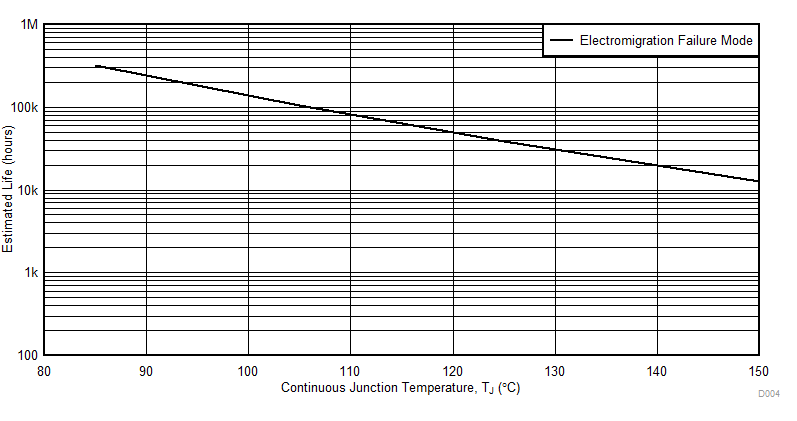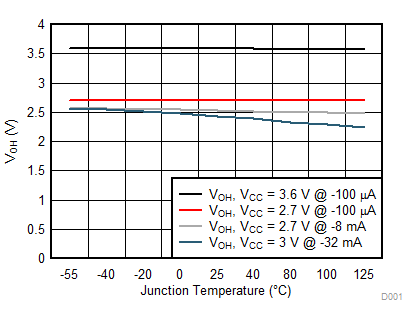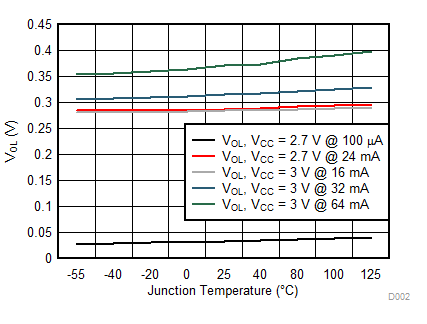SCBS778B November 2003 – June 2016 SN74LVTH16373-EP
PRODUCTION DATA.
- 1 Features
- 2 Applications
- 3 Description
- 4 Revision History
- 5 Pin Configuration and Functions
-
6 Specifications
- 6.1 Absolute Maximum Ratings
- 6.2 ESD Ratings
- 6.3 Recommended Operating Conditions
- 6.4 Thermal Information
- 6.5 Electrical Characteristics
- 6.6 Timing Requirements (I Version)
- 6.7 Switching Characteristics (I Version)
- 6.8 Timing Requirements (M Version)
- 6.9 Switching Characteristics (M Version)
- 6.10 Typical Characteristics
- 7 Parameter Measurement Information
- 8 Detailed Description
- 9 Application and Implementation
- 10Power Supply Recommendations
- 11Layout
- 12Device and Documentation Support
- 13Mechanical, Packaging, and Orderable Information
Package Options
Mechanical Data (Package|Pins)
Thermal pad, mechanical data (Package|Pins)
Orderable Information
6 Specifications
6.1 Absolute Maximum Ratings
over operating free-air temperature range (unless otherwise noted)(1)| MIN | MAX | UNIT | ||
|---|---|---|---|---|
| VCC | Supply voltage | –0.5 | 4.6 | V |
| VI | Input voltage(2) | –0.5 | 7 | V |
| VO | Voltage applied to any output in the high-impedance or power-off state(2) | –0.5 | 7 | V |
| VO | Voltage applied to any output in the high state(2) | –0.5 | VCC + 0.5 V | V |
| IO | Current into any output in the low state | 128 | mA | |
| IO | Current into any output in the high state(3) | 64 | mA | |
| IIK | Input clamp current (VI < 0) | –50 | mA | |
| IOK | Output clamp current (VO < 0) | –50 | mA | |
| Tstg | Storage temperature | –65 | 150 | °C |
(1) Stresses beyond those listed under Absolute Maximum Ratings may cause permanent damage to the device. These are stress ratings only, which do not imply functional operation of the device at these or any other conditions beyond those indicated under Recommended Operating Conditions. Exposure to absolute-maximum-rated conditions for extended periods may affect device reliability.
(2) The input and output negative-voltage ratings may be exceeded if the input and output clamp-current ratings are observed.
(3) This current flows only when the output is in the high state and VO > VCC.
6.2 ESD Ratings
| VALUE | UNIT | |||
|---|---|---|---|---|
| V(ESD) | Electrostatic discharge | Human body model (HBM), per A114-A | ±4000 | V |
| Charged device model (CDM), per JEDEC specification JESD22-C101(1) | ±3000 | V | ||
| Machine model (MM), per A115-A | 200 | V | ||
(1) JEDEC document JEP157 states that 250-V CDM allows safe manufacturing with a standard ESD control process.
6.3 Recommended Operating Conditions
over operating free-air temperature range (unless otherwise noted)(1)(1) All unused control inputs of the device must be held at VCC or GND to ensure proper device operation. Refer to the TI application report, Implications of Slow or Floating CMOS Inputs, SCBA004.
6.4 Thermal Information
| THERMAL METRIC(1)(2) | SN74LVTH16373-EP | UNIT | |||
|---|---|---|---|---|---|
| DGG (TSSOP) | DL (SSOP) | GQL (BGA MICROSTAR JUNIOR) | |||
| 48 PINS | 48 PINS | 56 PINS | |||
| RθJA | Junction-to-ambient thermal resistance | 68.9 | 60.3 | 62.5 | °C/W |
| RθJC(top) | Junction-to-case (top) thermal resistance | 14.6 | 31 | 24.7 | °C/W |
| RθJB | Junction-to-board thermal resistance | 35.8 | 32.1 | 28.9 | °C/W |
| ψJT | Junction-to-top characterization parameter | 2.4 | 9.3 | 0.9 | °C/W |
| ψJB | Junction-to-board characterization parameter | 35.5 | 31.8 | 28 | °C/W |
(1) For more information about traditional and new thermal metrics, see the Semiconductor and IC Package Thermal Metrics application report, SPRA953.
(2) The package thermal impedance is calculated in accordance with JESD 51-7.
6.5 Electrical Characteristics
over operating free-air temperature range (unless otherwise noted); all typical values are at VCC = 3.3 V, TA = 25°C| PARAMETER | TEST CONDITIONS | MIN | TYP | MAX | UNIT | ||
|---|---|---|---|---|---|---|---|
| VIK | VCC = 2.7 V, | II = –18 mA | –1.2 | V | |||
| VOH | VCC = 2.7 V to 3.6 V, | IOH = –100 µA | VCC – 0.2 | V | |||
| VCC = 2.7 V, | IOH = –8 mA | 2.4 | V | ||||
| VCC = 3 V, | IOH = –32 mA | 2 | V | ||||
| VOL | VCC = 2.7 V | IOL = 100 µA | 0.2 | V | |||
| IOL = 24 mA | 0.5 | V | |||||
| VCC = 3 V, | IOL = 16 mA | 0.4 | V | ||||
| IOL = 32 mA | 0.5 | V | |||||
| IOL = 64 mA | 0.55 | V | |||||
| II | VCC = 0 or 3.6 V, | VI = 5.5 V | 10 | µA | |||
| Control inputs | VCC = 3.6 V, | VI = VCC or GND | ±1 | µA | |||
| Data inputs | VCC = 3.6 V | VI = VCC | 1 | µA | |||
| VI = 0 | –5 | µA | |||||
| Ioff | VCC = 0, | VI or VO = 0 to 4.5 V | ±100 | µA | |||
| II(hold) | Data inputs | VCC = 3 V | VI = 0.8 V | 75 | µA | ||
| VI = 2 V | –75 | µA | |||||
| VCC = 3.6 V(1), | VI = 0 to 3.6 V | ±650 | µA | ||||
| IOZH | VCC = 3.6 V, | VO = 3 V | 5 | µA | |||
| IOZL | VCC = 3.6 V, | VO = 0.5 V | –5 | µA | |||
| IOZPU | VCC = 0 to 1.5 V, VO = 0.5 to 3 V, OE = don’t care | ±100 | µA | ||||
| IOZPD | VCC = 1.5 V to 0, VO = 0.5 to 3 V, OE = don’t care | ±100 | µA | ||||
| ICC | VCC = 3.6 V, IO = 0, VI = VCC or GND | Outputs high | 0.19 | mA | |||
| Outputs low | 5 | mA | |||||
| Outputs disabled | 0.19 | mA | |||||
| ∆ICC(2) | VCC = 3 to 3.6 V, One input at VCC − 0.6 V, Other inputs at VCC or GND | 0.2 | mA | ||||
| Ci | VI = 3 V or 0 | 3 | pF | ||||
| Co | VO = 3 V or 0 | 9 | pF | ||||
(1) This is the bus-hold maximum dynamic current. It is the minimum overdrive current required to switch the input from one state to another.
(2) This is the increase in supply current for each input that is at the specified TTL voltage level, rather than VCC or GND.
6.6 Timing Requirements (I Version)
over recommended operating conditions (unless otherwise noted); TA = –40°C to 85°C| MIN | MAX | UNIT | |||
|---|---|---|---|---|---|
| tw | Pulse duration, LE high | VCC = 3.3 V ± 0.3 V | 3 | ns | |
| VCC = 2.7 V | 3 | ns | |||
| tsu | Setup time, data before LE↓ | VCC = 3.3 V ± 0.3 V | 1 | ns | |
| VCC = 2.7 V | 0.6 | ns | |||
| th | Hold time, data after LE↓ | VCC = 3.3 V ± 0.3 V | 1 | ns | |
| VCC = 2.7 V | 1.1 | ns | |||
6.7 Switching Characteristics (I Version)
over recommended operating conditions (unless otherwise noted); TA = –40°C to 85°C; all typical values are at VCC = 3.3 V, TA = 25°C| PARAMETER | FROM (INPUT) | TO (OUTPUT) | TEST CONDITIONS | MIN | TYP | MAX | UNIT |
|---|---|---|---|---|---|---|---|
| tPLH | D | Q | VCC = 3.3 V ± 0.3 V | 1.5 | 2.7 | 3.8 | ns |
| VCC = 2.7 V | 4.2 | ns | |||||
| tPHL | D | Q | VCC = 3.3 V ± 0.3 V | 1.5 | 2.5 | 3.6 | ns |
| VCC = 2.7 V | 4 | ns | |||||
| tPLH | LE | Q | VCC = 3.3 V ± 0.3 V | 2.1 | 3 | 4.3 | ns |
| VCC = 2.7 V | 4.8 | ns | |||||
| tPHL | LE | Q | VCC = 3.3 V ± 0.3 V | 2.1 | 2.9 | 4 | ns |
| VCC = 2.7 V | 4 | ns | |||||
| tPZH | OE | Q | VCC = 3.3 V ± 0.3 V | 1.5 | 2.8 | 4.3 | ns |
| VCC = 2.7 V | 5.1 | ns | |||||
| tPZL | OE | Q | VCC = 3.3 V ± 0.3 V | 1.5 | 2.8 | 4.3 | ns |
| VCC = 2.7 V | 4.7 | ns | |||||
| tPHZ | OE | Q | VCC = 3.3 V ± 0.3 V | 2.4 | 3.5 | 5 | ns |
| VCC = 2.7 V | 5.4 | ns | |||||
| tPLZ | OE | Q | VCC = 3.3 V ± 0.3 V | 2 | 3.2 | 4.7 | ns |
| VCC = 2.7 V | 4.8 | ns | |||||
| tsk(o) | VCC = 3.3 V ± 0.3 V | 0.5 | ns |
6.8 Timing Requirements (M Version)
over recommended operating conditions (unless otherwise noted); TA = –55°C to 125°C6.9 Switching Characteristics (M Version)
over recommended operating conditions (unless otherwise noted); TA = –55°C to 125°C; all typical values are at VCC = 3.3 V, TA = 25°C| PARAMETER | FROM (INPUT) | TO (OUTPUT) | TEST CONDITIONS | MIN | TYP | MAX | UNIT |
|---|---|---|---|---|---|---|---|
| tPLH | D | Q | VCC = 3.3 V ± 0.3 V | 1.5 | 2.7 | 5 | ns |
| VCC = 2.7 V | 5.5 | ns | |||||
| tPHL | D | Q | VCC = 3.3 V ± 0.3 V | 1.5 | 2.5 | 4.8 | ns |
| VCC = 2.7 V | 5.3 | ns | |||||
| tPLH | LE | Q | VCC = 3.3 V ± 0.3 V | 2.1 | 3 | 5.4 | ns |
| VCC = 2.7 V | 5.9 | ns | |||||
| tPHL | LE | Q | VCC = 3.3 V ± 0.3 V | 2.1 | 2.9 | 4.9 | ns |
| VCC = 2.7 V | 4.9 | ns | |||||
| tPZH | OE | Q | VCC = 3.3 V ± 0.3 V | 1.5 | 2.8 | 7 | ns |
| VCC = 2.7 V | 7.9 | ns | |||||
| tPZL | OE | Q | VCC = 3.3 V ± 0.3 V | 1.5 | 2.8 | 6.2 | ns |
| VCC = 2.7 V | 7.2 | ns | |||||
| tPHZ | OE | Q | VCC = 3.3 V ± 0.3 V | 1.8 | 3.5 | 7.2 | ns |
| VCC = 2.7 V | 7.9 | ns | |||||
| tPLZ | OE | Q | VCC = 3.3 V ± 0.3 V | 2 | 3.2 | 5.2 | ns |
| VCC = 2.7 V | 5.4 | ns | |||||
| tsk(o) | VCC = 3.3 V ± 0.3 V | 0.5 | ns |

1. See data sheet for absolute maximum and minimum recommended operating conditions.
2. Silicon operating life design goal is 10 years at 105°C junction temperature (does not include package interconnect life).
3. Enhanced plastic product disclaimer applies.
Figure 1. Derating Chart for SN74LVTH16373-EP
6.10 Typical Characteristics

